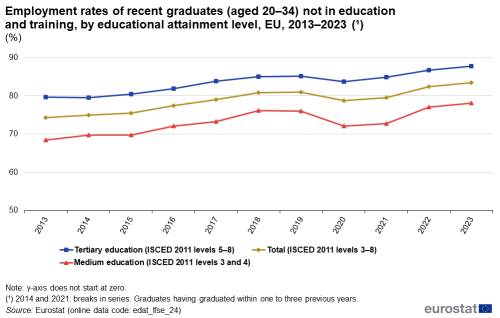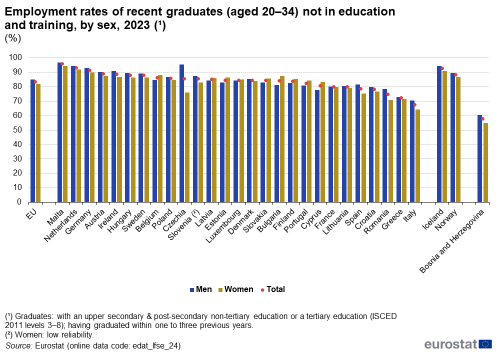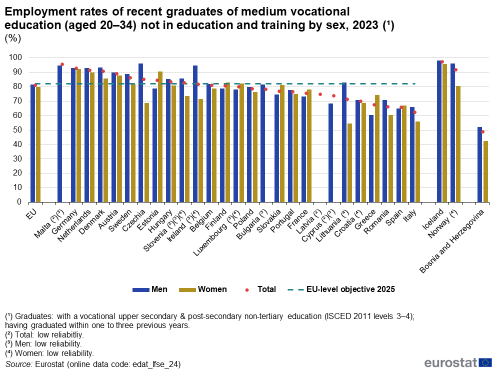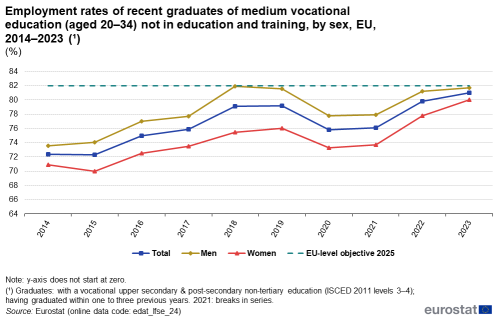Employment rates of recent graduates
Data extracted in May 2024.
Planned article update: June 2025.
Highlights
Employment rates of recent graduates (aged 20-34 years) not in education and training, by educational attainment level, EU, 2013-2023
This article presents statistics related to the employment rates of young adults aged 20–34 years who recently graduated from either upper secondary or tertiary levels of education in the European Union (EU). 'Recent graduates' are defined here as persons who, firstly, have attained at least upper secondary education (ISCED 3) as the highest level of education, secondly, have not received any (formal or non-formal) education or training in the four weeks preceding the survey and thirdly, have successfully completed their highest educational attainment 1, 2 or 3 years before the survey. Data come from the EU labour force survey. The article is included in a series of statistical articles forming part of the online publication Education and training in the EU - facts and figures.
The article provides information regarding the transition from education to work and analyses access to the labour market among recent graduates. It is important to make sure that the transition from education to work is smooth to avoid the risk of becoming a person neither in employment nor in education or training (NEET). The risk of becoming a NEET decreases with the level of education but it is still important to bear it in mind.
Each EU Member State is responsible for its own education and training system, though EU policies in this field are designed to address common challenges, while providing a forum for the exchange of best practices and sharing evidence of policy initiatives. Vocational education and training (VET) is a key element for lifelong learning systems, and there is an EU-level objective that the share of employed recent graduates from VET should be at least 82 % by 2025 for those aged 20-34 years. In 2023, this share amounted to 81.0 % in the EU.
Full article
Employment rates of recent graduates are highest for those with a tertiary educational attainment
Figure 1 presents the employment rates for recent graduates by level of educational attainment within the EU. It reveals that the highest employment rates in 2023 were recorded for those who had graduated with a tertiary education, while lower employment rates were recorded for those with an upper secondary or post-secondary non-tertiary education (i.e. with a medium level of education). Note that recent graduates with a vocational upper secondary or post-secondary non-tertiary education (hereafter referred to as 'medium vocational education') in most EU Member States recorded higher employment rates than those with a general upper secondary or post-secondary non-tertiary education (hereafter referred to as 'medium general education'). As such, it would appear that apprenticeships and other kinds of education programmes that equip students with the knowledge, know-how, skills and/or competences required for a particular occupation, increase the likelihood of recent graduates being able to find a job.
When looking into the details, Figure 1 shows that the EU employment rate for recent graduates in 2023 was 83.5 %. However, there are differences between the countries and the highest employment rates were found in Malta (95.8 %), the Netherlands (93.2 %) and Germany (91.5 %). The lowest employment rates were found in Italy (67.5 %), Greece (72.3 %) and Romania (74.8 %).
As previously stated, the level of educational attainment plays a key role when recent graduates seek employment. Those with a tertiary educational attainment recorded the highest employment rates and were generally better shielded from the risks of unemployment than their peers who entered the labour market with lower levels of educational attainment. In 2023, the employment rate of recent tertiary graduates was more than 90 % in Ireland, Austria, Belgium, Sweden, Slovakia, Poland, Germany, Latvia, Bulgaria, Hungary, the Netherlands, Malta and Estonia. There were two EU Member States where this indicator was less than 80 %: Greece and Italy.

(%)
Source: Eurostat (edat_lfse_24)
Employment rates of recent graduates in the last 10 years
When looking into the different types of recent graduates and their employment rates over time, the general pattern is the same, but the levels differ, depending on the educational attainment (see Figure 2).
Looking at the numbers in more detail, recent tertiary graduates had their lowest employment rate in 2014 (79.5 %). The share rose to 85.1 % in 2019, before going down in 2020 with the onset of the COVID-19 pandemic. After that, the share rose again and, at 87.7 % in 2023, it reached the highest level of the past 10 years.
Turning to recent graduates from medium education, the EU employment rate was at its lowest in 2013 (68.4 %). By contrast, the first peak for this subpopulation was recorded at 76.1 % in 2018. In 2020 there was a considerable decrease due to the COVID-19 pandemic, but the share rose again from 2021 to its highest level of 78.1 % in 2023.
In 2023, the gap in employment rates between recent tertiary graduates and recent graduates from medium education was 9.6 percentage points (pp), which was somewhat narrower than in 2013 and also in 2020 (around 11.5 pp). This gap was narrowest in 2018 (8.9 pp).

(%)
Source: Eurostat (edat_lfse_24)
Recent male graduates in the EU were more likely to find work than their female counterparts
In 2023, the EU employment rate of recent male graduates stood at 85.0 %, while the corresponding rate recorded among recent female graduates was 82.0 %, see Figure 3. This constitutes a difference of 3.0 pp between the sexes. Some of these differences may be explained by the nature of the field studied as there are differences in labour market demand. Women and men also tend to study different fields, for example, a higher proportion of science and technology students tend to be male.
The differences between the sexes vary between the EU Member States, both in magnitude and which sex has the higher employment rate. In 18 Member States men had a higher employment rate than women. The largest difference by far was found in Czechia where the employment rate for male graduates was 19.4 pp higher than for women. Nine Member States had a higher employment rate for women. The largest difference was found in Bulgaria where the employment rate was 6.0 pp higher among women than men.

(%)
Source: Eurostat (edat_lfse_24)
Several countries have reached the EU-level objective regarding medium vocational education for 2025 – but there are differences between the sexes
Bearing in mind that the EU strives to increase the employment rates for recent graduates of medium vocational education to 82 % by 2025, this section focuses on this objective. Across the EU Member States there are wide variations both between countries but also within countries when the results are divided between women and men, see Figure 4.
In the EU, the employment rate of recent graduates of medium vocational education amounted to 81.0 % in 2023. The share was higher for men (81.7 %) than for women (80.0 %), which means a difference between the sexes of 1.7 pp.
Looking at the employment rates for recent graduates of medium vocational education there are 10 EU Member States that had already reached the EU-level objective of at least 82 % in 2023. The countries that have already reached this level are: Malta, Germany, the Netherlands, Denmark, Austria, Sweden, Czechia, Estonia, Hungary and Slovenia. In Germany, the Netherlands, Denmark, Austria and Malta the goal was also met for men and women separately, which was not the case for the other countries that had reached the objective. The countries with the lowest employment rates were Italy (62.2 %), Spain (65.8 %), Romania (66.2 %) and Greece (67.4 %). This means that the employment rates for recent graduates of medium vocational education in the EU Member States ranged from 62.2 % in Italy to 95.6 % in Malta in 2023.
Looking at the EU Member States in more detail, the numbers show that countries have differences between the sexes, both in magnitude and which sex has the higher employment rate. Out of the 23 EU Member States for which data is available for both women and men, 16 Member States men had a higher employment rate than women. The largest difference in favour of male graduates from medium vocational education was found in Lithuania (28.4 pp) followed by Czechia (27.1 pp) and Ireland (23.2 pp). However, seven Member States reported a higher employment rate for women. Where this is the case, the largest differences between the sexes were found in Greece (13.8 pp) followed by Estonia (11.7 pp).

(%)
Source: Eurostat (edat_lfse_24)
Recent male graduates of medium vocational education had higher employment rates than women in the last 10 years
The results from 2023 show that in the EU men in general had a higher employment rate than women for recent graduates of medium vocational education, which is also true when looking back in time. The employment rates have been higher for men over time but the general pattern of the evolution is similar for both women and men. The gender gap has varied in magnitude and was at its lowest in 2023 at 1.7 pp. The largest difference was observed in 2018 and amounted to 6.4 pp in favour of men. With the onset of the COVID-19 pandemic in 2020, the rates fell sharply both for women and men. In 2023, the rates for both sexes increased substantially and were higher than the pre-pandemic level of 2019. With this, achieving the goal for 2025 appears in reach for men, while for women the employment rate still needs to rise considerably.

(%)
Source: Eurostat (edat_lfse_24)
Source data for tables and graphs
Data sources
The EU labour force survey (LFS) provides statistics on employment rates of recent graduates. The LFS is documented in this background article which provides information on the scope of the data, its legal basis, the methodology employed, as well as related concepts and definitions.
Key concepts
The employment rate is obtained by dividing the number of persons in employment (according to the ILO definition) of a particular age group by the total population of the same age group. The indicator for recent graduates is calculated for the age group 20–34 and concerns those who had successfully completed their highest level of education one to three years beforehand. The term 'graduate' refers to any person who has left education and training with at least an upper-secondary or post-secondary, non-tertiary qualification or with a tertiary qualification (ISCED 2011 levels 3–8). The denominator for the ratio is based solely on those persons who were no longer in (formal or non-formal) education or training and hence excludes both:
- those who continue to follow their studies while working (for example, part-time jobs, seasonal work, holiday jobs);
- those who are primarily working but at the same time engaged in some form of education or training, for example, apprentices.
For the purpose of this article, graduates are defined as those who entered and successfully completed an education programme. The information presented refers to those students who graduated from ISCED 2011 levels 3–8. Graduates are only counted once, at the level of the highest programme successfully completed.
Levels of educational attainment
Common definitions for education systems have been agreed between the UNESCO Institute for Statistics (UIS), the OECD and Eurostat. UNESCO developed the International standard classification of education (ISCED) to facilitate comparisons across countries on the basis of uniform and internationally agreed definitions. In 2011, a revision to the ISCED was formally adopted, referred to as ISCED 2011. Prior to this, ISCED 1997 was used as the common standard for classifying education systems. Note that Eurostat statistics on employment rates of recent graduates have a break in series in 2014 when the first information collected under the ISCED 2011 classification became available; prior to this date these statistics were collected using ISCED 1997. For more information, see the article on the ISCED classification.
Note on symbols used in tables
The colon (':') is used to show where data are not available.
Context
Principle 1 of the European pillar of social rights states that "everyone has the right to quality and inclusive education, training and lifelong learning in order to maintain and acquire skills that enable them to participate fully in society and manage successfully transitions in the labour market". The European Skills Agenda is a five-year plan to support skills development. Equipping people with the right skills helps them to adjust to changes that come along with technological developments in the way we work, learn, take part in society and lead our everyday lives. The right skills help individuals to adjust to these changes and ensure their well-being while contributing to society, productivity and economic growth. The 'Youth guarantee' calls on EU Member States to ensure that all young people under the age of 25 years receive a good quality offer of employment, continued education, an apprenticeship or a traineeship within four months of leaving formal education or becoming unemployed. Its main aim is to help tackle youth unemployment and to smooth the transition from education to work. The reinforced youth guarantee extended the target population to all young people under the age of 30 years.
Following CEDEFOP's definition, vocational education and training (VET) can be understood as education and training which aims to equip young people and adults with knowledge, skills and competences required in particular occupations or more broadly on the labour market. Council Recommendation of 24 November 2020 on vocational education and training (VET) for sustainable competitiveness, social fairness and resilience calls for work towards achieving by 2025 three EU-level objectives, including the objective that the share of employed graduates from VET should be at least 82 %.
The overall state of an economy is an important determinant for both the availability and the quality of job opportunities. With a downturn in economic fortunes resulting from the global financial and economic crisis in the late 2000s or the recent COVID-19 pandemic, graduates in the EU faced a range of difficulties when trying to enter labour markets, with persistently high unemployment rates and many graduates accepting work for which they were over-qualified or unqualified. Such a mismatch may result from differences between occupations and qualifications (a vertical mismatch), or from differences between occupations and fields of study (a horizontal mismatch); the former is generally more common within the EU (see also the dedicated section on Skills).
Direct access to
- Education and training outcomes (t_educ_outc)
- Education and training outcomes (educ_outc)
- Transition from education to work (edatt)
Metadata
- Educational attainment level and transition from education to work (ESMS metadata file — edat1_esms)
Manuals and other methodological information